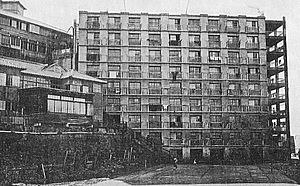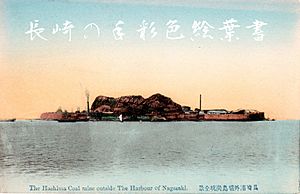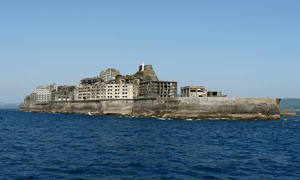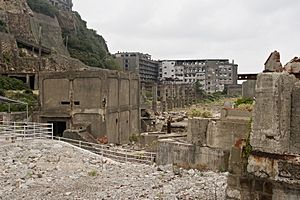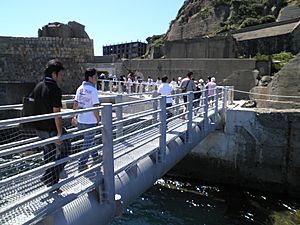Hashima Island facts for kids
|
Native name:
端島
Nickname: Battleship Island
|
|
|---|---|

Aerial view
|
|
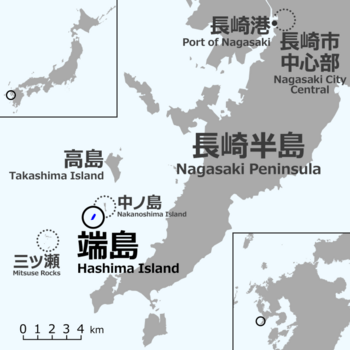 |
|
| Geography | |
| Location | Northeast Asia |
| Area | 0.063 km2 (0.024 sq mi) |
| Area rank | none |
| Administration | |
| Prefecture | |
| City | |
| Demographics | |
| Population | 0 (2020) |
Hashima Island (端島, or simply Hashima) is a small, abandoned island near Nagasaki, Japan. It's about 15 kilometers (9 miles) from the city center. People often call it Gunkanjima (軍艦島, meaning 'Battleship Island').
This island is famous for its old concrete buildings and the strong walls around it. Nature has slowly taken over these buildings. Hashima shows how fast Japan grew as an industrial country. But it also reminds us of a difficult time in history, as people were forced to work there before and during World War II.
Hashima is about 6.3 hectares (15.6 acres) in size. It was once known for its undersea coal mines. These mines started in 1887. The island had many people living there, reaching a peak of 5,259 in 1959.
In 1974, the coal was running out. The mine closed, and everyone left the island. For about 30 years, Hashima was empty.
Later, people became interested in the island's old buildings. It slowly became a place for tourists to visit. Some broken walls have been fixed. Tourists could visit Hashima again starting April 22, 2009.
Because of this growing interest, people wanted to protect the island. In July 2015, the island's coal mine became a UNESCO World Heritage Site. It is part of the "Sites of Japan's Meiji Industrial Revolution." Japan agreed to share the history of forced labor on the island.
Contents
What's in a Name? Battleship Island
The name Battleship Island is an English translation of the Japanese name Gunkanjima. In Japanese, gunkan means warship, and jima means island.
The island got this nickname because it looks like a battleship from far away. People thought it looked like the Japanese battleship Tosa.
Hashima's History: From Coal to Ghost Town
Coal was first found on Hashima around 1810. People lived and worked on the island from 1887 to 1974. They mined coal from under the sea.
In 1890, a company called Mitsubishi bought the island. They started digging for coal. They also built seawalls and added more land, making the island three times bigger. Workers dug four main mine shafts, some going a kilometer (0.6 miles) deep. One shaft even connected to a nearby island. From 1891 to 1974, workers dug out about 15.7 million tons of coal. The mines were very hot and humid.
In 1916, Mitsubishi built Japan's first large reinforced concrete building. It was a 7-story apartment building for miners. Concrete was used to protect against strong storms called typhoons. Over the next 55 years, more buildings were added. These included more apartments, a school, a hospital, and a town hall. For fun, there was a clubhouse, a movie theater, a swimming pool, and shops.
From the 1930s until the end of World War II, many people were forced to work on the island. These included Korean civilians and Chinese prisoners of war. They worked under very difficult and harsh conditions. Many of these workers died on the island. This was due to accidents, exhaustion, or not having enough food.
In 1959, the island had its largest population: 5,259 people. This made it one of the most crowded places on Earth at the time.
In the 1960s, Japan started using more petroleum instead of coal. Many coal mines closed down, including Hashima's. Mitsubishi officially closed the mine in January 1974. By April 20, all the people had left the island.
Today, Hashima is known for its abandoned concrete buildings. They are still mostly standing. The island has been part of Nagasaki city since 2005. Tourists can visit a small part of the island since April 22, 2009.
Hashima Today: A Ruined Treasure
Mitsubishi owned the island until 2002. Then, it was given to Takashima Town. Now, Nagasaki City manages the island. In 2005, journalists were allowed to visit. The city planned to fix a pier for tourists by 2008. They also planned a walkway for visitors. People would not be allowed into unsafe buildings.
Because of delays, public access was pushed back to 2009. There were also safety worries. The old buildings might collapse.
It was thought that tourists could only land on the island fewer than 160 days a year. This is because of the bad weather in the area. A small part of the island opened for tourism in 2009. But more than 95% of the island is still off-limits. It would cost a lot to make the whole island safe. This might also change its historical look.
The island is getting more attention around the world. People are interested in its modern history. They also like seeing the old buildings from the Taishō and Shōwa periods. It's a popular spot for people who like exploring ruins. Since no one has maintained the island, some buildings have fallen down. This is mostly due to typhoon damage. Other buildings are also at risk. However, some broken outer walls have been repaired with concrete.
How to Visit Hashima Island
When people lived on Hashima, a boat line connected it to Nagasaki Port. Boats also stopped at Iōjima Island and Takashima Island. In 1970, there were 12 boat trips each day. The trip from Hashima to Nagasaki took 50 minutes. This direct boat route stopped after everyone left the island.
Since April 2009, the island has been open for public visits. However, Nagasaki city has rules about where visitors can go.
Today, five companies offer boat trips around or to the island. These include Gunkanjima Concierge and Gunkanjima Cruise Co., Ltd. Most boats leave from Nagasaki Port. There is also a private service from the Nomozaki Peninsula.
See also
 In Spanish: Hashima para niños
In Spanish: Hashima para niños


